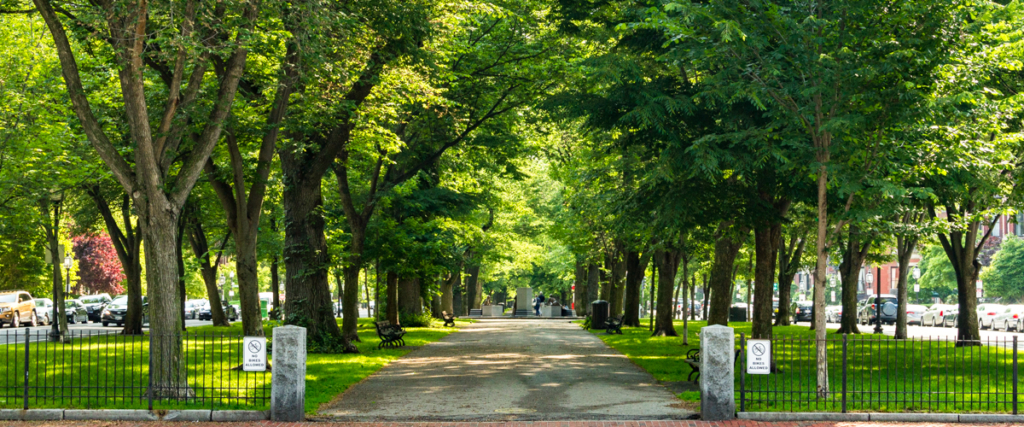
Remember the 6 billion microorganisms found in a single teaspoon of healthy soil? Well, now we know more about our soil and those microorganisms. We have results from the Friends’ initial baseline soil testing program.
The results include both the biologic and chemical composition of the soil. These reports about soil analysis affecting the balance in the soil system are complex, so buckle up!
Before diving into the data, it’s important to consider the urban soil landscape. Urban vegetation and soils face many challenges not experienced by its natural, unmodified brethren (aka the forest or a meadow). The city environment removes many natural processes. Perhaps most important, in an old city like Boston, metropolitan soils are not native to the space, but are modified as most have been brought in as landfill. In an urban setting, sunlight availability, temperature variations, and air quality all impact the soil, and, of course, they are under stress from intensity of use. Our strategy, an organic approach, attempts to replicate natural processes to create a vibrant plant community through sustainable and responsible practices.
The initial data reveals much about the elements, biology and their relationships to one another within the parks’ soil. As this data affects soil management, trends become visible in annual soil data.
One of the more important components of soil analysis is pH, or how acidic/alkaline the soil environment is. The pH scale itself runs from 0-14 with 7 being neutral. A soil may contain plenty of a specific element, but this is the important part, pH will dictate whether that element is accessible to the plant in an appropriate quantity or not.
The pH data we got is telling: all three parks are some factor below optimum pH values. The Mall, for instance, is the most acidic of the three parks, between 10x and 100x too acidic for many turf varieties. The Boston Common had similar pH values about three years ago. At that point, the Friends applied 80 tons of limestone to begin correcting this issue. Limestone application is a commonly accepted means of lowering acidity in soils. Since that application, the pH has improved by a factor of 10, or an entire point on the pH scale. While the pH on the Common isn’t perfect yet, it is trending towards a more conducive environment for turfgrass. Like many adjustments to soil conditions, correcting pH is not an immediate fix, and requires a few seasons and perhaps a couple applications of limestone before the desired results are achieved.
Back to those 6 billion microorganisms. Another part of the analysis is the biologic data. The results indicate the total population numbers of different species of soil biology/microoganisms and what portion of that total population is active. Many of the organisms in the soil environment can be dormant and affected by numerous environmental factors, including available food sources, moisture, oxygen, and pH. Good news/bad news, the data demonstrate adequate total populations; however, rather low proportions of those totals are active. Given pH across the parks, especially on the Mall, low active numbers aren’t surprising. Correcting pH should have a positive effect on desirable biotic activity where the pH is very low. Other areas of low biotic activity can be corrected by adjusting the other environmental variables mentioned previously.
The Plan
As mentioned in the November e-news, there is no “silver bullet” to improving soil health, rather a tapestry woven with different strategies and methods that come together over time to provide a beautiful and healthy urban greenspace for people, plants, and wildlife to safely enjoy.
These are some of the steps the Friends, with our partner, the Parks Department will be carefully evaluating in our efforts to implement a plan to improve the soil health throughout the three parks:
• Remediating soil pH through limestone applications in targeted areas to increase soil alkalinity.
• Targeting specific nutrient deficiencies through foliar applications to boost plant health and increase root zones, inevitably increasing habitat and foods for soil biology.
• Over-seeding with specific turfgrass varieties that are more tolerant of challenging growing conditions across the three parks, which include: Drought, building shade, low pH, high salt content from de-icing operations, heavy usage
• Increasing the amount of productive soil organic matter through compost topdressing during turf renovations in the fall. This compost will help to: Increase diversity and density of soil biology, protect freshly applied grass seed from gluttonous pigeons and squirrels, increase soil to seed contact for higher germination percentages, increase food sources for existing and introduced biology through targeted applications to reduce dormancy and in turn boost plant-available nutrients.
Adjusting soil inputs based on what the soil data is communicating is important, but not the only focus to improving plant and soil health. Changing maintenance practices and routines are also important. This involves:
• Increasing awareness of the importance of implementing turfgrass rest periods after large-scale events and other periods of extreme stress.
• Increasing turfgrass recovery efficiencies through targeted applications post events.
• Improving irrigation management by way of a smart irrigation system, first used in 2019, which allows far more control over watering timing and quantities, improving soil moisture management.
• Improving mowing practices by: Alternating mowing patterns to reduce compaction areas, returning the clippings back into the turn, increasing mow heights to 3.5” to protect from weed establishment, improve shoot to root ratios and reduce extreme soil temperature fluctuations
• Never removing more than 1/3 of the grass blade per mow, reducing shock to the plant
A lot to digest, but all in the service of making the lawns in our parks happy and healthy for all of us to enjoy!

